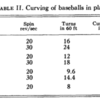It took a Saturday with no college football (besides FCS) for me to clear my brain and put some thought into this whole spin rate thing. I say this as a guy who is not a pitcher and who did not develop his kid as a pitcher, but one who just has to say that I think we have gotten way out over our skis on measuring stuff. Whether it is launch angle, exit velocity, or spin rate, I just think we have made all of these particular metrics mean more than they really should. That said, I am sure there are people on here who are going to disagree and cite studies or stats to back themselves up, while I offer none of that. What I am offering as evidence is common sense (lord help me).
Spin rate really entered the lexicon once we started using advanced radar to measure pitch speeds. Spin rate is measured in rotations per minute (RPM). A 90 MPH fastball takes about 0.458 seconds to reach home plate from 60’6” away. Most pitchers deliver their pitches from closer than than when you account for their stride, but let’s use 60’6” as a baseline. If we use an average spin rate of 2,300 RPM as an example, that would mean the baseball is rotating at 38.33 rotations per second (RPS). A pitcher with what is perceived as high spin would get about 42 RPS. Remember, from 60’6” it’s taking the baseball thrown 90 MPH 0.458 seconds to reach home plate. So it really only has the opportunity to rotate, at 38 RPS, about 17.4 times on its trip to home plate. It’s really not that overwhelming. High spin rate guys get about 19.2 rotations on the ball. Am I missing something here? Rotation certainly impacts pitch movement, but by extrapolating the actual spin into RPM makes it seem like these pitches are attached to a high speed drill...when in fact they really only spin a fraction of that rate given the time it is in the air. Regardless of the spin rate, a batter still is capable of hitting the baseball squarely if they can time it up and get on plane with the pitch.
While I am at it, my thought on launch angle is “it is what it is. If you try to force it, your K rate will likely increase.” Exit velocity - same thing.
Would like to hear your thoughts, folks.

